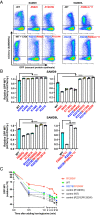Structure and function of an effector domain in antiviral factors and tumor suppressors SAMD9 and SAMD9L
- PMID: 35046037
- PMCID: PMC8795524
- DOI: 10.1073/pnas.2116550119
Structure and function of an effector domain in antiviral factors and tumor suppressors SAMD9 and SAMD9L
Abstract
SAMD9 and SAMD9L (SAMD9/9L) are antiviral factors and tumor suppressors, playing a critical role in innate immune defense against poxviruses and the development of myeloid tumors. SAMD9/9L mutations with a gain-of-function (GoF) in inhibiting cell growth cause multisystem developmental disorders including many pediatric myelodysplastic syndromes. Predicted to be multidomain proteins with an architecture like that of the NOD-like receptors, SAMD9/9L molecular functions and domain structures are largely unknown. Here, we identified a SAMD9/9L effector domain that functions by binding to double-stranded nucleic acids (dsNA) and determined the crystal structure of the domain in complex with DNA. Aided with precise mutations that differentially perturb dsNA binding, we demonstrated that the antiviral and antiproliferative functions of the wild-type and GoF SAMD9/9L variants rely on dsNA binding by the effector domain. Furthermore, we showed that GoF variants inhibit global protein synthesis, reduce translation elongation, and induce proteotoxic stress response, which all require dsNA binding by the effector domain. The identification of the structure and function of a SAMD9/9L effector domain provides a therapeutic target for SAMD9/9L-associated human diseases.
Keywords: NOD; innate immunity; myelodysplasia syndrome; myeloid malignancies; poxvirus.
Copyright © 2022 the Author(s). Published by PNAS.
Conflict of interest statement
The authors declare no competing interest.
Figures





References
-
- Narumi S., et al. , SAMD9 mutations cause a novel multisystem disorder, MIRAGE syndrome, and are associated with loss of chromosome 7. Nat. Genet. 48, 792–797 (2016). - PubMed
Publication types
MeSH terms
Substances
Grants and funding
LinkOut - more resources
Full Text Sources
Other Literature Sources
Molecular Biology Databases

